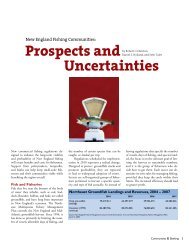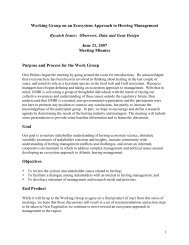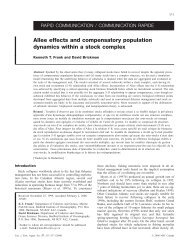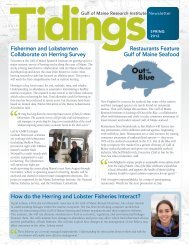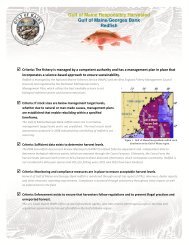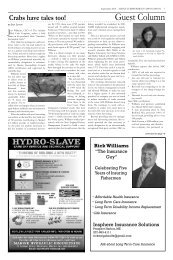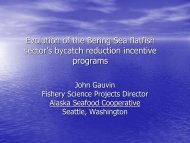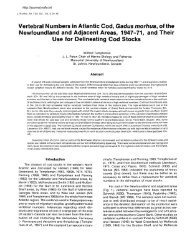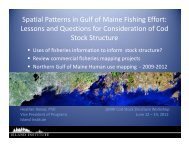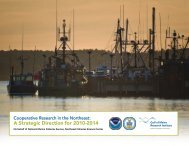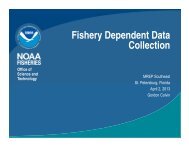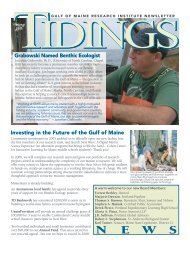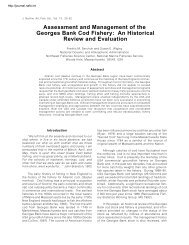Community-based Sectors for the New England Groundfish Fishery
Community-based Sectors for the New England Groundfish Fishery
Community-based Sectors for the New England Groundfish Fishery
Create successful ePaper yourself
Turn your PDF publications into a flip-book with our unique Google optimized e-Paper software.
increased. They also have caught a larger share of <strong>the</strong> hake and plaice but a smaller share of witch<br />
flounder and winter flounder. These trends are consistent with <strong>the</strong> dealer data and <strong>the</strong> sector<br />
allocations calculated from it <strong>based</strong> on <strong>the</strong> 96-01 vs. 01-05 fishing years which were shown in<br />
Table 2.<br />
These long term trends probably reflect changes in <strong>the</strong> distribution of stocks but also regulatory<br />
changes such as rolling closures and trip limits. They also reflect changes in overall stock levels<br />
and commercial catches. There<strong>for</strong>e it is difficult to say how easily <strong>the</strong> sector could adjust to a set<br />
of TACs that reflect older catch history (e.g. 1996-2001). Elimination of DAS limits, trip limits<br />
and rolling closures and would give sector vessels considerably more flexibility to adjust <strong>the</strong>ir<br />
species composition. If sector allocations were <strong>based</strong> on <strong>the</strong> earlier years it might require some<br />
spatial or temporal shifting of <strong>the</strong> sector’s ef<strong>for</strong>t. However, since catches <strong>for</strong> most species have<br />
been well below <strong>the</strong> target TACs, <strong>the</strong> sector TACs are likely to allow <strong>the</strong> sector to increase<br />
catches of most stocks without being constrained by TACs of stocks which <strong>the</strong>y caught a smaller<br />
percentage of in <strong>the</strong> allocation years.<br />
Perhaps a more serious problem <strong>for</strong> <strong>the</strong> sector will be constraining TACs <strong>for</strong> species that are not a<br />
significant part of <strong>the</strong>ir landings history (as recorded in dealer data) and are probably taken<br />
primarily as incidental catch when targeting o<strong>the</strong>r species. For species such as yellowtail<br />
flounder, windowpane flounder and winter flounder, <strong>the</strong> sector will receive very small TACs.<br />
Their landings, while small in absolute magnitude, have been and are likely to continue to be<br />
quite variable in percentage terms over time. The sector may find itself constrained by <strong>the</strong>se<br />
TACs that are of little importance to <strong>the</strong>ir overall profitability unless <strong>the</strong>y can find ways to avoid<br />
<strong>the</strong>m. Again, spatial and temporal shifts in ef<strong>for</strong>t may mitigate this problem, but this may result in<br />
reductions in efficiency if <strong>the</strong> vessels are required to <strong>for</strong>go high catch rates of <strong>the</strong>ir primary target<br />
species in order to avoid <strong>the</strong>se o<strong>the</strong>r stocks. Allowing sectors to trade ACE during <strong>the</strong> fishing<br />
year could be quite beneficial in this case, particularly if <strong>the</strong> distribution of <strong>the</strong>se stocks is shifting<br />
from year to year causing relative catch rates in different areas to change.<br />
3.2 Portland <strong>Community</strong>-<strong>based</strong> <strong>Groundfish</strong> <strong>Sectors</strong><br />
In my initial discussions with fishermen and boat owners in Portland about <strong>the</strong> idea of a<br />
community-<strong>based</strong> sector and sectors in general, <strong>the</strong>re was limited interest in sectors as a<br />
management system and some misconceptions about how <strong>the</strong>y would operate. Most people I<br />
spoke with were skeptical about whe<strong>the</strong>r sectors would deliver economic benefits sufficient to<br />
outweigh <strong>the</strong> costs and risks associated with developing sectors. Most also assumed sectors would<br />
necessarily operate in a way similar to <strong>the</strong> GB Hook sector which sets monthly TACs that are<br />
fished competitively by its members. They had not contemplated an operational plan that<br />
subdivided <strong>the</strong> sector allocation amongst its individual members on <strong>the</strong> basis of <strong>the</strong> catch history<br />
each brought to <strong>the</strong> sector. The idea of setting up an individual allocation system in <strong>the</strong> sector’s<br />
operating plan with trading of ACE allowed between sector members was deemed a more<br />
desirable or acceptable way of operating <strong>the</strong> sector by most of <strong>the</strong> individuals I spoke with who<br />
expressed interest in this <strong>for</strong>m of management.<br />
The motivations <strong>for</strong> considering sectors expressed by permit holders were primarily related to<br />
<strong>the</strong>ir own profitability. While most of <strong>the</strong> individuals did not express great enthusiasm <strong>for</strong> sector<br />
management, many, though not all, also agreed that <strong>the</strong> current system was seriously undermining<br />
<strong>the</strong>ir economic viability and that sectors might offer <strong>the</strong> possibility of improving <strong>the</strong>ir<br />
profitability through greater ability to access stocks <strong>for</strong> which catches are currently well below<br />
25



